December 1, 2014
by Mikhail Elyashberg, Leading Researcher, ACD/Labs
Puberunine
Aconitum barbatum Pers. var. puberulum Ledeb. (Subgen Lycoctonum), a herb distributed in the northern part of China, as well as in the Siberia region of Mongolia and Russia, has long been used in China as a folk medicine to treat rheumatism and pain. While studying this herb, Mu et al [1] isolated six new C18-diterpenoid alkaloids including Puberunine (1) that possesses an unusual rearranged 7-membered ring, highlighted in red. This structural feature is unprecedented in the field of diterpenoid alkaloids.
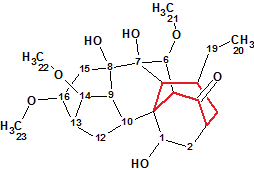
1
Puberunine, isolated as a colorless amorphous solid, was shown by HRESI-TOF-MS (m/z 438.2496 [M + H]+, calculated 438.2486) to have the molecular formula C23H35NO7.
Absorption bands in the IR spectrum indicate the presence of hydroxyl (3600-3000 cm-1) and carbonyl (1712 cm-1) groups.
In this example, we attempt to elucidate the novel structure of Puberunine using ACD/Structure Elucidator Suite. The original spectroscopic data [1] are found in Table 1, which were then used to create the Molecular Connectivity Diagram is shown in Figure 1.
Table 1: Spectroscopic NMR data for Puberunine.
| Label | δX | δC cld | XHn | δH | COSY | HMBC |
| C 1 | 69.5 | 69.86 | CH | 3.67 | 2.53, 2.03 | C 17, C 10 |
| C 2 | 39.3 | 36.01 | CH2 | 2.53 | 3.67, 2.65 | |
| C 2 | 39.3 | 36.01 | CH2 | 2.03 | 3.67 | C 3, C 4, C 1 |
| C 3 | 48.8 | 45.69 | CH | 2.65 | 2.53, 3.07, 3.25 | C 2 |
| C 4 | 213.7 | 213.8 | C | |||
| C 5 | 60.8 | 54.83 | CH | 2.35 | 3.00, 4.14 | C 6, C 17, C 4 |
| C 6 | 92.9 | 87.5 | CH | 4.14 | 2.35, 3.00, 3.50 | C 8, C 4, C 7, C 5 |
| C 7 | 87.7 | 88.11 | C | |||
| C 8 | 79.2 | 79.84 | C | |||
| C 9 | 44.2 | 44.25 | CH | 2.63 | 2.10, 3.70 | C 12, C 13, C 8 |
| C 10 | 48 | 43.27 | CH | 2.1 | 1.92, 2.27, 2.63 | C 8 |
| C 11 | 53 | 52.97 | C | |||
| C 12 | 28 | 29.34 | CH2 | 2.27 | 2.1 | C 11, C 14, C 16 |
| C 12 | 28 | 29.34 | CH2 | 1.92 | 2.45, 2.10 | C 16, C 10 |
| C 13 | 39 | 38.07 | CH | 2.45 | 1.92, 3.70 | C 9 |
| C 14 | 83.6 | 84.77 | CH | 3.7 | 2.45, 2.63, 3.43 | |
| C 15 | 34.3 | 38.16 | CH2 | 1.75 | 3.23, 4.27 | C 8, C 7, C 16 |
| C 15 | 34.3 | 38.16 | CH2 | 2.7 | 3.23 | C 16, C 13, C 9, C 7, C 8 |
| C 16 | 83.1 | 78.54 | CH | 3.23 | 1.75, 2.70, 3.37 | C 14, C 12, C 15, C 13 |
| C 17 | 65.4 | 71.12 | CH | 3 | 2.35, 4.14 | C 19, C 10, C 6, C 5, C 8, C 11, C 18 |
| C 18 | 51.2 | 54.67 | CH2 | 3.25 | 2.65 | C 17, C 4 |
| C 18 | 51.2 | 54.67 | CH2 | 3.07 | 2.65 | C 4, C 17, C 3 |
| C 19 | 50.4 | 49.28 | CH2 | 2.96 | C 17, C 18 | |
| C 19 | 50.4 | 49.28 | CH2 | 3.21 | 1.19 | C 17, C 20, C 18 |
| C 20 | 14.5 | 13.49 | CH3 | 1.19 | 3.21 | C 19 |
| C 21 | 59.3 | 60.43 | CH3 | 3.5 | 4.14 | C 6 |
| C 22 | 57.9 | 58.54 | CH3 | 3.43 | 3.7 | C 14 |
| C 23 | 56.3 | 56.75 | CH3 | 3.37 | 3.23 | C 16 |
| O 1 | 100* | OH | 4.27 | 1.75 | C 15, C 8 |
*Fictitious 17O chemical shift
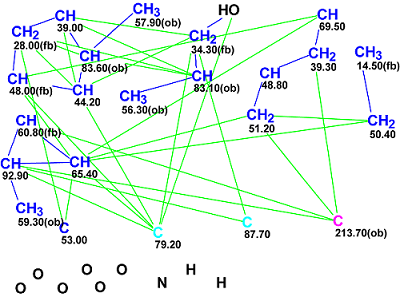
Figure 1. Molecular Connectivity Diagram for Puberunine.
No user edits of the connectivities and atom properties were made. Checking
the MCD for inconsistencies revealed the presence of some contradictions. Fuzzy Structure Generation was therefore initiated using the mode “Determine Options Automatically”. The results were: k = 480→216→25,tg = 1 s. It turned out that the best structure of the ranked file (structure 2) was characterized by large deviations, and
additionally the length of one COSY correlation was of 7 bonds:
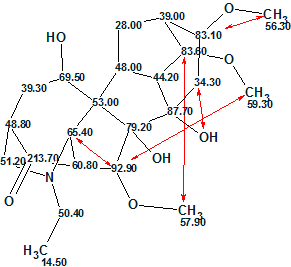
2
As five correlations were automatically elongated by the program then the next run was performed with parameters m=6, a=1. Results: k= 22→10→10, tg= 3 s, 820 of 8,145,060 combinations of connectivities were used during the Fuzzy Generation. Three top structures of the ranked output structural file are shown in Figure 2.
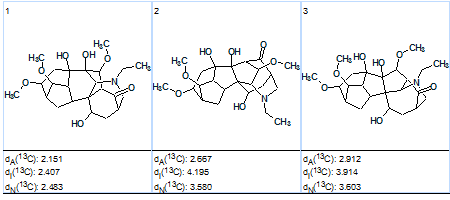
Figure 2. The top structures of the ranked output structural file for Puberunine.
The highest-ranked structure in Figure 2 is structure 1; the 13C chemical shift assignment is displayed on structure 3. Six COSY nonstandard correlations
detected by the program are marked by red arrows.
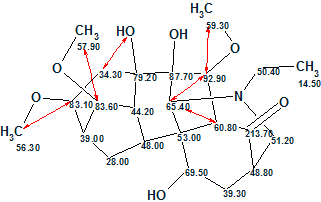
3
At the end of the article [1] the authors underline once more that puberunine possesses an unprecedented skeleton containing a rearranged seven-membered ring (consisting of C-3, C-4, C-5, C-11, C-17, N, and C-18), in which the C18-C4 bond typically present in C18- and C19-diterpenoid alkaloids is missing and a new C18-C3 bond exists. Even for such a unique compound, the structure was able to be determined by Structure Elucidator Suite automatically and instantly.
References
- Mu ZQ, Gao H, Huang ZY, Feng XL, Yao XS. (2012). Puberunine and puberudine, two new C18-diterpenoid alkaloids from Aconitum barbatum var. puberulum. Org Lett 14(11):2758–2761. doi:10.1021/ol3008217


